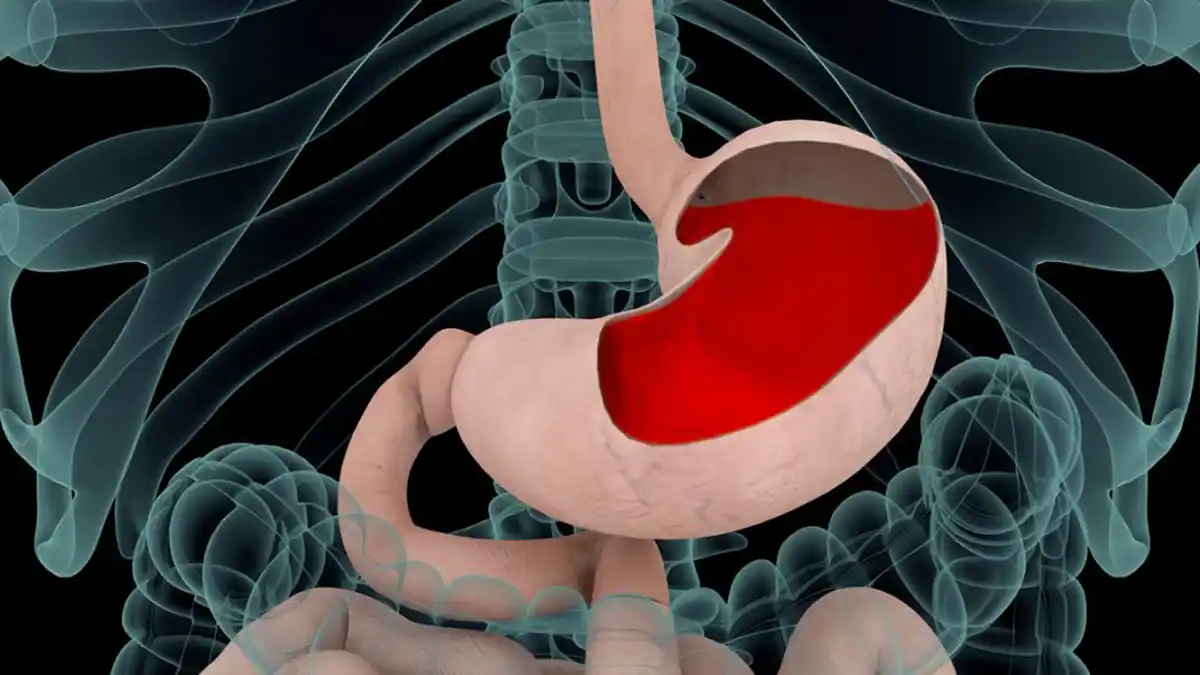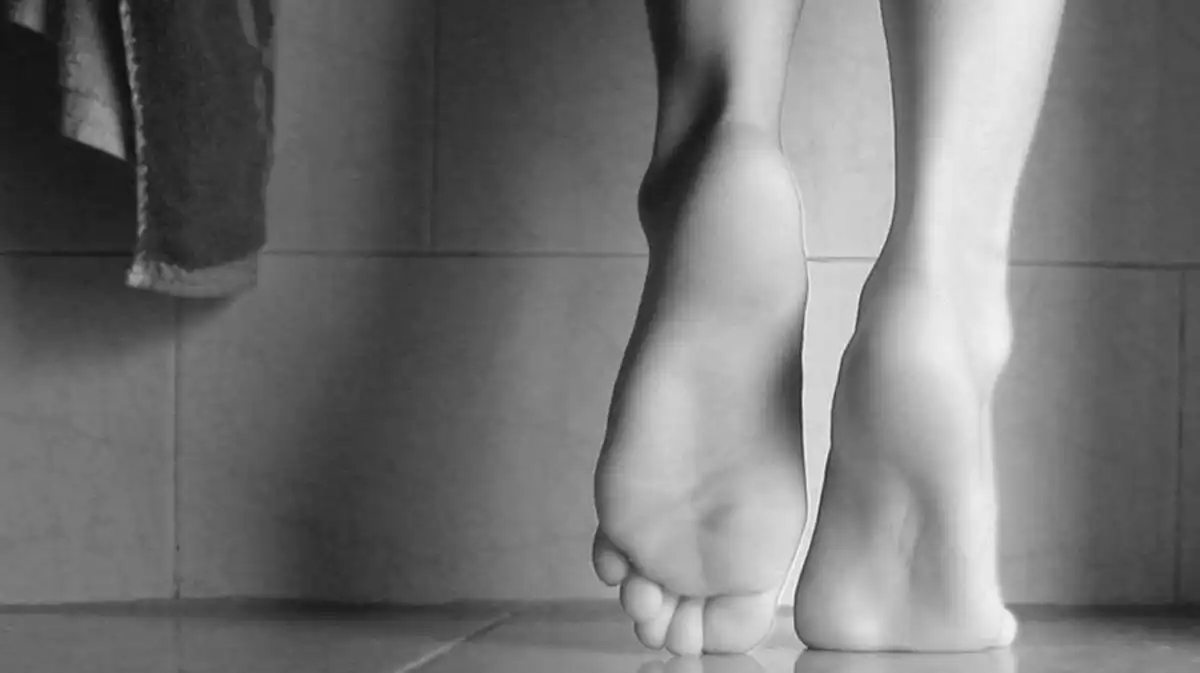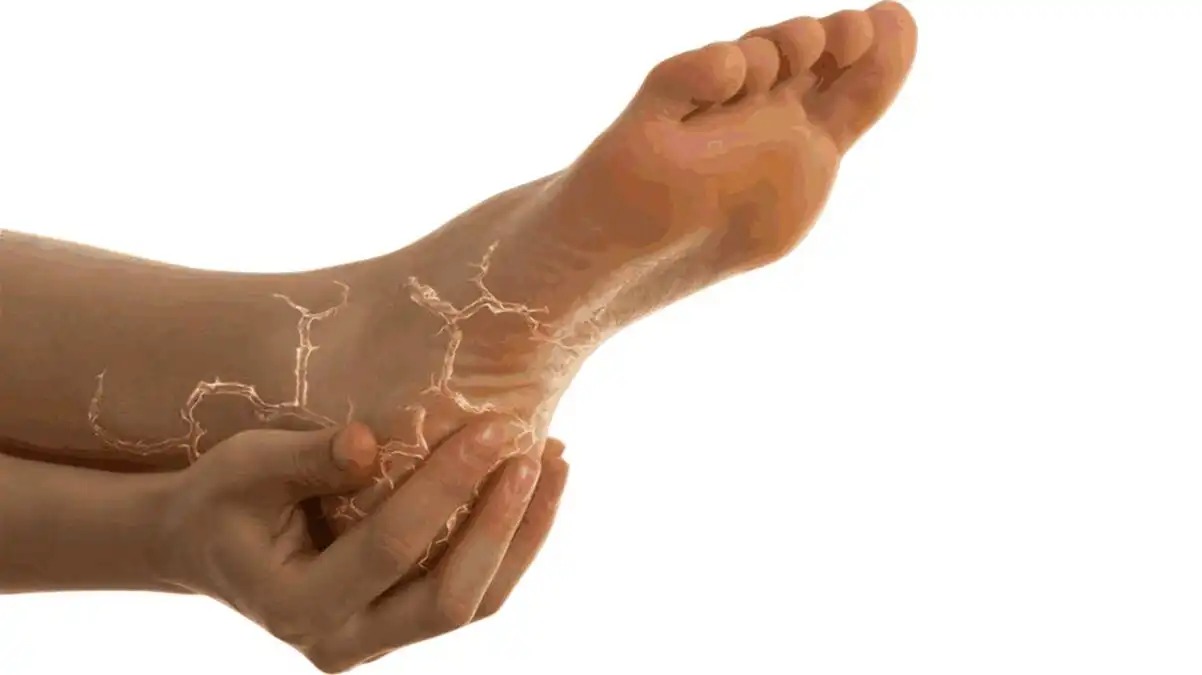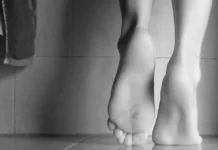Introduction
Gastroesophageal Reflux Disease (GERD) is a chronic digestive condition that occurs when stomach acid or bile flows back into the esophagus, irritating the lining and causing a range of uncomfortable symptoms. These symptoms often include heartburn, regurgitation, chest pain, and difficulty swallowing (dysphagia). GERD affects millions of people worldwide and, if left untreated, can lead to severe complications such as esophagitis, Barrett’s esophagus, and an increased risk of esophageal cancer.
The primary cause of GERD is dysfunction of the lower esophageal sphincter (LES), a muscle that normally acts as a valve to prevent acid reflux. When the LES is weakened or relaxes inappropriately, stomach contents can escape into the esophagus, leading to acid irritation. Several factors can contribute to GERD, including obesity, pregnancy, hiatal hernia, smoking, and certain foods or eating habits. Over time, GERD can greatly impact a person’s quality of life, interfering with daily activities, work performance, and sleep due to persistent discomfort and symptoms.
Beyond digestive discomfort, GERD can also lead to respiratory complications such as chronic coughs, asthma flare-ups, and even sinus infections. The acid exposure can also harm dental enamel and disrupt sleep, further diminishing overall health and well-being. Effective management of GERD is, therefore, essential not only for alleviating symptoms but also for maintaining long-term health.
Osteopathy offers a holistic approach to managing GERD by addressing not only the symptoms but also the underlying structural and functional imbalances that may contribute to the condition. Osteopathic manipulative treatment (OMT) focuses on improving the body’s ability to heal itself by correcting dysfunctions in the musculoskeletal, circulatory, and nervous systems.
The Role of the Treitz Ligament in GERD Management
One area of particular interest within osteopathic management of GERD is the Treitz ligament, a structure often overlooked in conventional treatments. The Treitz ligament, also known as the suspensory muscle of the duodenum, plays a crucial role in stabilizing the junction between the duodenum and the stomach. Its positioning and function directly impact the mechanics of the digestive system, particularly in maintaining the appropriate angle for digestive flow and ensuring that the stomach and esophagus remain aligned.
When there is tension, tightness, or dysfunction in the Treitz ligament, it can affect both the diaphragm and the lower esophageal sphincter, leading to mechanical disruptions that exacerbate GERD symptoms. Addressing this dysfunction through osteopathic techniques, particularly Treitz ligament release, can offer significant relief by restoring balance and mobility in the affected structures.
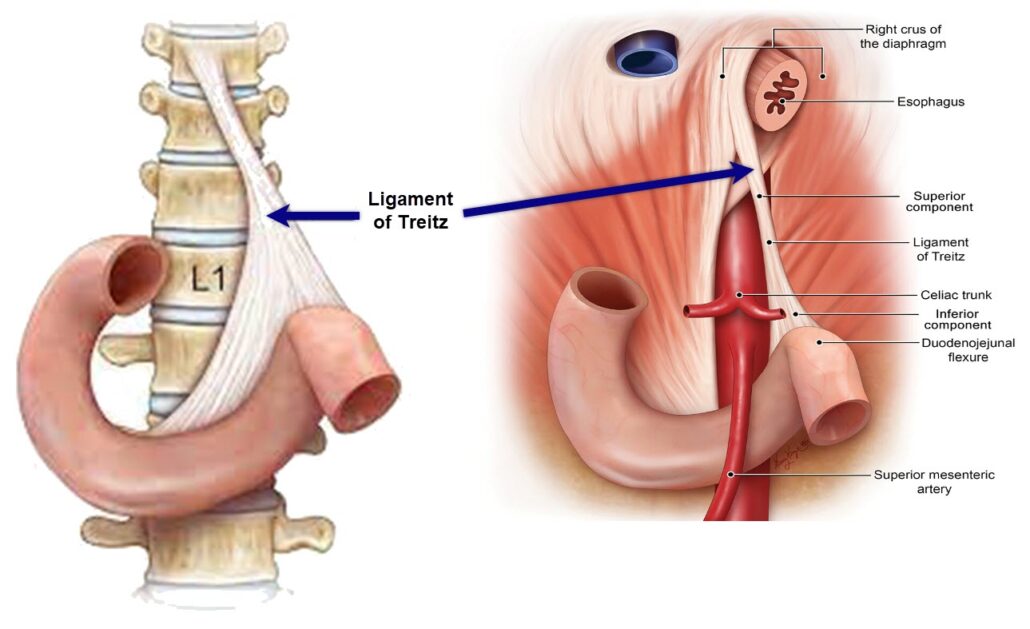
This illustration highlights the Ligament of Treitz, a key anatomical structure that plays an important role in maintaining the alignment and function of the digestive tract. The ligament, also known as the suspensory muscle of the duodenum, connects the duodenojejunal flexure to the diaphragm near the first lumbar vertebra (L1). By supporting the transition from the duodenum to the jejunum, it helps maintain proper digestive flow and positioning of the small intestine.
Additionally, the ligament influences the mechanics of the surrounding organs, particularly the diaphragm and lower esophageal sphincter (LES), which are essential in preventing acid reflux. Dysfunction in the Treitz ligament may lead to digestive disturbances such as Gastroesophageal Reflux Disease (GERD) by altering the pressure balance around the LES. Osteopathic treatment targeting this ligament, such as Treitz ligament release, aims to relieve tension and restore balance in the surrounding fascial and muscular structures, potentially improving symptoms related to GERD and enhancing overall digestive health.
This anatomical illustration also showcases related structures, including the celiac trunk, superior mesenteric artery, and esophagus, providing a comprehensive view of the ligament’s relationships within the digestive system.
Key Osteopathic Approaches in GERD Management
Osteopathic treatment of GERD typically involves a combination of techniques aimed at improving the mobility and function of the diaphragm, esophagus, and surrounding ligaments. By addressing structural imbalances in these areas, osteopaths can help reduce the frequency and severity of acid reflux episodes.
- Diaphragmatic Mobilization:
The diaphragm plays a critical role in GERD, as it supports the esophagus and helps maintain the integrity of the LES. Tension or restrictions in the diaphragm can compromise LES function, making reflux more likely. Osteopathic practitioners work to release tension in the diaphragm through specific manipulative techniques, which can enhance LES competence and reduce acid backflow. - Thoracic and Abdominal Manipulation:
Structural issues in the thoracic (chest) or abdominal regions, such as misalignment of the spine or tension in the abdominal muscles, can affect the positioning and function of the stomach and esophagus. Osteopaths employ manipulative techniques to improve spinal alignment, reduce muscle tension, and optimize gastrointestinal motility. - Visceral Manipulation:
This osteopathic technique involves gentle manual manipulation of the organs, including the stomach and esophagus, to promote better organ function and reduce tension. By targeting the structures involved in digestion, such as the diaphragm, LES, and surrounding fascia, visceral manipulation can help reduce the frequency and severity of reflux episodes. - Postural Dysfunction and Lymphatic Drainage:
Poor posture can place extra pressure on the stomach and diaphragm, exacerbating GERD symptoms. Osteopaths may work to correct postural imbalances and recommend exercises or stretches to maintain good posture, helping to prevent acid reflux and improve digestive function. Additionally, improving lymphatic circulation through osteopathic techniques can help reduce inflammation and promote healing in the esophagus, supporting the body’s natural recovery processes.
Understanding Gastroesophageal Reflux
Gastroesophageal Reflux Disease (GERD) is a chronic condition characterized by the backflow of stomach contents into the esophagus, causing discomfort and potential long-term damage. Understanding its symptoms, causes, and associated structures like the ligament of Treitz can aid in effectively managing the condition.
Definition and Symptoms of GERD
GERD occurs when the lower esophageal sphincter (LES), a ring-like muscle at the junction of the stomach and esophagus, weakens or relaxes inappropriately. This malfunction allows stomach acid and food to flow back into the esophagus, causing irritation. Unlike the stomach, the esophagus lacks a protective lining, so even small amounts of acid can cause significant discomfort and damage.
Common Symptoms of GERD Include:
- Heartburn: A burning sensation in the chest, often after eating or when lying down.
- Regurgitation: Sour or bitter-tasting acid backing up into the throat or mouth.
- Dysphagia: Difficulty swallowing due to inflammation or narrowing of the esophagus.
- Chest Pain: Can mimic heart attack symptoms and may require medical evaluation to distinguish between the two.
- Chronic Cough or Hoarseness: Stomach acid reaching the throat can cause irritation, leading to persistent cough or hoarseness.
- Asthma-like Symptoms: In some cases, acid reflux can worsen or trigger asthma symptoms such as wheezing or shortness of breath.
Causes and Contributing Factors
GERD has a variety of causes, ranging from mechanical dysfunction to lifestyle habits. Recognizing these factors is crucial in the diagnosis and treatment of the condition.
- Lower Esophageal Sphincter Dysfunction:
- The LES typically prevents the contents of the stomach from flowing back into the esophagus. GERD occurs when this muscle weakens or relaxes abnormally, allowing acid to escape.
- Hiatal Hernia:
- A hiatal hernia occurs when part of the stomach moves up into the chest through an opening in the diaphragm. This condition weakens the LES and is a major risk factor for GERD.
- Obesity:
- Excess abdominal fat increases pressure on the stomach, pushing acid into the esophagus. Studies consistently show that GERD symptoms are more prevalent in people with obesity due to this additional pressure.
- Pregnancy:
- Hormonal changes during pregnancy, combined with the pressure of the growing uterus on the stomach, contribute to acid reflux in pregnant women, especially in the later stages.
- Smoking:
- Nicotine weakens the LES and reduces saliva production, which plays a key role in neutralizing stomach acid, thus exacerbating GERD symptoms. Smoking also impairs the esophagus’s ability to clear acid effectively.
- Dietary Triggers:
- Certain foods and beverages can worsen GERD. Common triggers include:
- Fatty or fried foods: Slow digestion and increase acid production.
- Citrus fruits and tomato-based products: Their acidity can irritate the esophagus.
- Chocolate, caffeine, and alcohol: All can relax the LES, allowing acid to escape.
- Spicy foods: Irritate the esophagus and stomach lining.
- Certain foods and beverages can worsen GERD. Common triggers include:
- Eating Habits:
- Eating large meals or lying down immediately after eating can trigger acid reflux. The risk of reflux increases with the amount of food in the stomach, as well as in a supine position.
- Stress and Anxiety:
- Psychological stress does not cause GERD, but it can intensify symptoms. Stress may alter the perception of pain, making the discomfort of acid reflux feel more intense.
- Delayed Stomach Emptying (Gastroparesis):
- Gastroparesis, a condition where the stomach takes longer to empty, increases the risk of reflux by allowing food and acid to remain in the stomach for extended periods.
The Ligament of Treitz and Its Role in GERD
The ligament of Treitz, named after Czech anatomist Václav Treitz, is a fibrous structure that plays a critical role in stabilizing the duodenojejunal junction, which is the junction between the duodenum (the first part of the small intestine) and the jejunum (the second part). This ligament helps maintain the alignment of the upper gastrointestinal tract and facilitates the proper movement of food from the stomach into the small intestine.
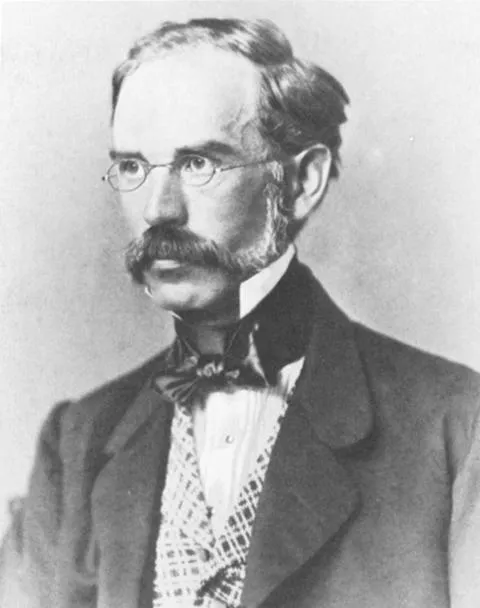
Key Functions of the Ligament of Treitz:
- It serves as an anchor point for the duodenojejunal junction, preventing the excessive mobility of the small intestine, which can disrupt digestion.
- It helps coordinate the passage of food from the stomach into the small intestine, ensuring that the digestive process occurs smoothly.
When the ligament becomes restricted or tense, it can have negative implications for gastrointestinal function, potentially contributing to GERD. Dysfunction in the ligament of Treitz can impair the mobility of the small intestine and the efficient movement of food, leading to symptoms like bloating, abdominal discomfort, and altered bowel movements.
Consequences of Dysfunction:
- Excessive tension in the ligament of Treitz can cause difficulty in passing food through the duodenojejunal junction, resulting in delayed gastric emptying, a known contributor to GERD.
- In some cases, weakness or laxity in the ligament may lead to anatomical instability, predisposing individuals to complications such as intestinal herniation or volvulus (intestinal twisting).
By restricting the smooth passage of food and delaying gastric emptying, dysfunction in this ligament can worsen symptoms of GERD, as the longer food remains in the stomach, the more likely it is that acid will reflux into the esophagus. Osteopathic treatments or manual therapies aimed at releasing tension in the ligament can restore its normal function, improving the mobility of the digestive system and reducing GERD symptoms.
Treitz Ligament Release: Osteopathic Approach
The Treitz ligament, also known as the suspensory ligament of the duodenum, plays a crucial role in gastrointestinal function and stability. As an anatomical structure, it connects the duodenojejunal flexure (the junction between the duodenum and the jejunum) to the diaphragm, ensuring that the digestive organs remain in their proper alignment. Its role is to provide structural support, particularly during digestion when food is moving from the stomach into the small intestine. When this ligament becomes tense or restricted, it can impede gastrointestinal function, leading to symptoms such as bloating, discomfort, and digestive irregularities.
Function of the Ligament of Treitz
The ligament of Treitz acts as a stabilizing force for the duodenojejunal flexure, keeping the small intestine in position during digestion. This structural support is critical in maintaining the appropriate anatomical relationship between the stomach and the small intestine, ensuring smooth passage of food from one to the other. Additionally, the ligament helps in the coordination of peristalsis, the wave-like muscular contractions that move food through the digestive tract.
When functioning optimally, the Treitz ligament allows for efficient mixing and propulsion of food from the stomach into the duodenum, where the next stage of digestion occurs. However, dysfunction in this ligament—whether due to tension, adhesions, or other restrictions—can affect the overall mobility of the small intestine. This can lead to a cascade of digestive symptoms including poor gastrointestinal motility, acid reflux, and discomfort due to incomplete digestion.
Dysfunction in the Treitz ligament can also have a ripple effect on surrounding structures, including the diaphragm and esophagus, potentially leading to symptoms like gastroesophageal reflux disease (GERD) or difficulty swallowing. This relationship underscores the importance of proper ligament function for overall digestive health.
Goals of the Treitz Ligament Release Technique
The osteopathic release of the Treitz ligament is a therapeutic technique aimed at improving gastrointestinal motility and relieving digestive symptoms caused by restrictions in the ligament and surrounding structures. The primary goals of this release technique are to:
- Alleviate Tension in the Ligament:
- The primary objective of Treitz ligament release is to reduce tension and restrictions in the ligament itself. Tension in the ligament can cause dysfunction in the digestive tract, leading to impaired mobility and digestion. Osteopathic practitioners use gentle manipulation techniques to release this tension, thereby restoring normal ligament function.
- Improve Gastrointestinal Mobility:
- Restrictions in the ligament of Treitz can impede the smooth passage of food through the digestive system, particularly at the junction between the duodenum and jejunum. By releasing tension and restoring flexibility in the ligament, the goal is to improve gastrointestinal motility, enhancing the natural movement of food and digestive fluids. This can result in more efficient digestion, reduced bloating, and relief from symptoms of GERD.
- Enhance Structural Alignment:
- Another key goal of the release technique is to improve the alignment of the gastrointestinal organs. By ensuring that the duodenojejunal flexure and surrounding tissues are correctly aligned, the technique can help relieve mechanical stress on the digestive tract. This may also reduce the risk of acid reflux, as proper alignment can improve the function of the lower esophageal sphincter (LES), preventing stomach acid from moving back into the esophagus.
- Promote Overall Digestive Health:
- By restoring balance in the ligament of Treitz and the surrounding structures, the technique aims to optimize digestive function as a whole. This not only relieves symptoms but also promotes long-term gastrointestinal health by improving nutrient absorption and reducing inflammation. Enhanced digestion can help prevent chronic digestive issues and reduce the burden on other digestive organs, such as the stomach and liver.
- Influence the Autonomic Nervous System:
- The Treitz ligament is closely associated with the autonomic nervous system (ANS), which regulates many involuntary bodily functions, including digestion. Dysfunction in the ligament can disrupt the balance between the sympathetic and parasympathetic nervous systems, leading to issues such as poor gastrointestinal motility and increased acid production. The release technique can help restore the normal functioning of the ANS, supporting better digestion and reducing stress-related symptoms like GERD.
- Relieve Symptoms of GERD and Other Digestive Disorders:
- By addressing the root cause of certain digestive symptoms, such as GERD, the Treitz ligament release technique can provide relief from heartburn, regurgitation, and other common signs of acid reflux. For individuals with functional digestive disorders, such as irritable bowel syndrome (IBS) or bloating, this technique offers a non-invasive and holistic approach to symptom management.
Mechanism of Treitz Ligament Release
The Treitz ligament release is an osteopathic technique that addresses tension in the ligament and surrounding structures to improve gastrointestinal function. This maneuver is designed to alleviate restrictions and realign the gastrointestinal system, particularly at the duodenojejunal junction, where the ligament of Treitz plays a critical role in stabilizing the digestive tract. Understanding the mechanisms behind this release technique reveals how it can restore normal digestive function and relieve symptoms like bloating, GERD, and other gastrointestinal issues.
Release of Tension and Structural Realignment
The ligament of Treitz, also called the suspensory ligament of the duodenum, attaches the duodenojejunal flexure to the right crus of the diaphragm. This attachment ensures the stability of the small intestine during digestion, particularly at the point where food passes from the stomach into the small intestine. However, when tension develops in the ligament—due to factors like postural imbalances, injury, or chronic digestive issues—it can impair the mobility of the digestive organs, leading to dysfunction.
The Treitz ligament release technique involves manual manipulation aimed at relieving tension in the ligament and the surrounding fascia. Osteopathic practitioners use their hands to gently stretch and manipulate the tissues around the ligament, helping to release adhesions and restrictions that have developed over time. This process restores the ligament’s natural flexibility and allows the digestive organs to move freely within the abdominal cavity.
Structural realignment is a key goal of the release technique. By restoring the proper positioning of the duodenojejunal flexure and its associated tissues, the maneuver helps realign the gastrointestinal system. When the digestive tract is properly aligned, it can function more efficiently, and the risk of symptoms like acid reflux, abdominal discomfort, or delayed gastric emptying is reduced. Additionally, releasing tension in the ligament can also alleviate pressure on other nearby structures, such as the diaphragm and esophagus, which may contribute to conditions like GERD.
Influence on Gastrointestinal Mobility and Digestion
A key aspect of the Treitz ligament’s function is its influence on gastrointestinal mobility—the process by which food moves through the digestive system. The ligament helps coordinate the peristaltic movements of the duodenum and jejunum, ensuring that food is properly mixed and pushed along the small intestine. When there is tension in the ligament, this coordinated movement can become disrupted, leading to slowed or impaired digestion.
By releasing tension in the ligament, the Treitz ligament release technique helps restore normal gastrointestinal motility. The improved flexibility of the ligament allows the duodenojejunal junction to function optimally, promoting smooth and efficient peristaltic waves. This, in turn, facilitates the proper mixing of digestive enzymes with food, enhancing the breakdown of nutrients and their absorption into the bloodstream.
The technique also has a positive impact on digestive flow. When the ligament of Treitz is tense, it can restrict the flow of food and gastric juices through the small intestine, causing symptoms such as bloating, gas, and incomplete digestion. By addressing these restrictions, the release technique enhances the flow of contents through the small intestine, helping to prevent stagnation and improve overall digestive health.
Moreover, the release of tension in the ligament can reduce acid reflux and other GERD symptoms. When the ligament is tense, it can exert pressure on the surrounding structures, including the lower esophageal sphincter (LES). This pressure can weaken the LES’s ability to close properly, allowing stomach acid to flow back into the esophagus. By releasing the tension and restoring the normal anatomical positioning of the gastrointestinal organs, the technique can help strengthen the LES’s function, reducing the occurrence of acid reflux.
In addition to improving mechanical function, the release technique has broader implications for the autonomic nervous system (ANS), which regulates many involuntary bodily functions, including digestion. The ligament of Treitz is connected to the diaphragm and is influenced by the balance between the sympathetic and parasympathetic branches of the ANS. By reducing tension in the ligament and promoting better alignment of the digestive organs, the technique can help restore autonomic balance, supporting healthy digestion and reducing symptoms of stress-related digestive issues.
Clinical Considerations and Patient Positioning
This maneuver, carried out by health professionals such as osteopaths, aims to release tensions or restrictions that may impact the Treitz ligament and surrounding structures. It is often applied in the context of gastrointestinal disorders, including gastroesophageal reflux disease (GERD) and other conditions related to abdominal tension.
It is crucial to emphasize that these techniques require the expertise of trained professionals and are tailored to the individual assessment of the patient. Treitz ligament release is part of a holistic approach to improving mobility and anatomical function, thereby contributing positively to the patient’s overall health.
A key aspect of this approach concerns the functional balance of the diaphragm, particularly in relation to the lower esophageal sphincter (LES). The left and right pillars of the diaphragm play a key role in closing this sphincter, establishing a significant muscular connection between the trunk and the diaphragm.
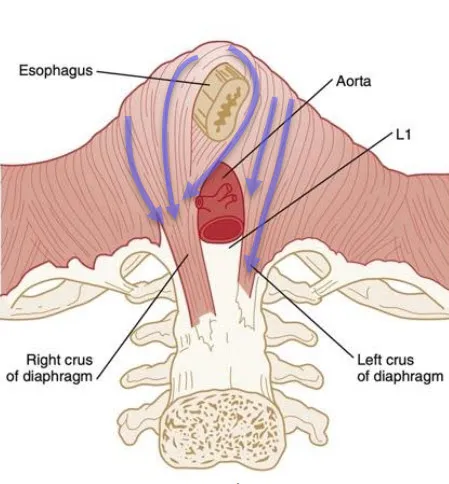
Step-by-Step Procedure
Detailed Procedure: Treitz Ligament Osteopathic Release Maneuver
The Treitz Ligament (or ligament of Treitz), a crucial anatomical structure, plays an important role in supporting the junction between the duodenum and the jejunum in the gastrointestinal tract. While it is primarily known for its function in holding the duodenum in place, its involvement in digestive function can be impacted by tension or dysfunction, leading to various digestive issues. Osteopathic release techniques target this ligament to alleviate such dysfunction, restore balance in the body, and improve gastrointestinal motility. Below is a step-by-step guide to performing the Treitz Ligament Osteopathic Release Maneuver.
1. Patient Assessment and Preparation
- Initial Consultation:
- Before performing the maneuver, the osteopathic physician conducts a thorough patient history, focusing on gastrointestinal symptoms like bloating, acid reflux, abdominal discomfort, or altered bowel habits.
- Palpation of the abdomen helps identify areas of restriction or tension in the surrounding structures such as the diaphragm, spine, and abdominal organs.
- Positioning the Patient:
- The patient is typically placed in a supine position (lying on their back) with the knees bent to allow for relaxation of the abdominal muscles.
- Alternatively, the patient can be positioned on their left side to promote relaxation in the abdominal cavity, depending on the practitioner’s preference.
- Breathing Preparation:
- Deep, diaphragmatic breathing is encouraged before beginning the technique to relax the abdominal muscles and release tension in the diaphragm, a key structure connected to the Treitz ligament.
2. Identifying the Treitz Ligament
- Palpation Landmarks:
- The Treitz ligament is located at the junction between the duodenum and jejunum, anchored at the diaphragm’s right crus.
- The osteopathic practitioner palpates the region slightly above and to the left of the umbilicus to identify tension in the area.
- Additional palpation through the epigastric region may be used to localize any areas of restriction in the small intestine and upper gastrointestinal tract.
- Assessing Tissue Tension:
- The practitioner assesses the mobility and flexibility of the tissues surrounding the Treitz ligament. Areas of stiffness, tension, or asymmetry in the connective tissues or fascia could indicate the need for release.
3. Performing the Release
- Direct or Indirect Technique:
- The osteopathic release of the Treitz ligament can be approached using either a direct or indirect technique, depending on the condition of the tissues and patient tolerance.
- Direct Technique:
- Involves applying gentle, sustained pressure directly over the ligament and surrounding fascia.
- The practitioner uses their fingers to engage the restricted tissue, slowly applying force until a barrier is felt, then holding this position until a softening or “release” of the tissue is achieved.
- Indirect Technique:
- The indirect method involves moving the tissues in the direction of least resistance, allowing the body’s natural mechanics to release the restriction.
- The practitioner may gently compress or rotate the tissues away from the barrier to facilitate this release.
- Gentle Oscillation:
- Oscillatory motion may be used to enhance the release, with subtle rocking movements encouraging fluidity and reduction of tension in the ligament.
- Visceral Manipulation:
- In addition to direct palpation, visceral manipulation techniques may be applied to the surrounding abdominal organs (stomach, duodenum, and jejunum), helping to mobilize the structures attached to the Treitz ligament and improve overall gastrointestinal function.
4. Post-Release Assessment and Follow-Up
- Reassessing Tissue Mobility:
- Once the release is complete, the osteopathic physician reassesses the tissue mobility around the duodenum and jejunum to confirm that tension has been alleviated.
- Improvement in the elasticity of the connective tissues and a decrease in patient-reported discomfort are good indicators of a successful release.
- Monitoring Patient Response:
- The patient’s symptomatic response is monitored immediately after the release. A sense of relief, reduction in bloating, or improved digestion may be reported.
- Follow-up sessions may be scheduled to ensure that the release is maintained and to address any lingering or recurring dysfunction in the ligament or surrounding structures.
- Self-Care Recommendations:
- The patient is often advised on posture, diaphragmatic breathing exercises, and gentle stretches to maintain the release and prevent future restrictions.
- Nutritional advice may also be provided to optimize gastrointestinal function and support long-term healing.
Additional Benefits and Clinical Considerations of Treitz Ligament Release
The autonomic nervous system (ANS) plays a critical role in regulating involuntary bodily functions, including digestion. The Treitz ligament release technique can positively influence the balance between the sympathetic and parasympathetic nervous systems, which control stress responses and digestion. By reducing tension in the ligament and restoring proper alignment in the gastrointestinal system, this technique promotes parasympathetic activity, enhancing digestive processes and relaxation. Patients often experience a reduction in stress-related symptoms like acid reflux, bloating, and abdominal discomfort.
Additionally, this technique supports the body’s natural healing mechanisms by improving blood flow and lymphatic circulation in the abdominal region. Better circulation helps reduce inflammation, promote tissue repair, and facilitate more efficient nutrient absorption. As a result, the overall well-being of the patient can improve, including better energy levels, mood, and sleep patterns. The holistic benefits of this release go beyond digestive health, positively affecting the nervous system and contributing to a general sense of well-being.
Other Conditions Potentially Addressed Through the Technique
While the primary focus of the Treitz ligament release technique is improving gastrointestinal function, the procedure may also benefit other conditions due to its effects on fascial and visceral mobility. These conditions include:
List of additional ailments
Low Back Pain: The Treitz Ligament Release Maneuver may help alleviate tension and restrictions in the connective tissue around the lumbar spine, potentially reducing symptoms of low back pain. By addressing fascial restrictions and improving biomechanical alignment, this technique may contribute to the relief of musculoskeletal strain and discomfort in the lumbar region.
Pelvic Dysfunction: Dysfunction in the pelvic region, including pelvic pain, sacroiliac joint dysfunction, or pelvic floor dysfunction, may benefit from the Treitz Ligament Release Maneuver. By releasing tension in the abdominal and pelvic fascia, this technique may improve pelvic biomechanics and alleviate symptoms associated with pelvic instability or muscular imbalances.
Digestive Disorders: In addition to its primary use in addressing gastrointestinal dysfunction, the Treitz Ligament Release Maneuver may be employed in the management of various digestive disorders, such as irritable bowel syndrome (IBS), constipation, or gastroesophageal reflux disease (GERD). By releasing tension in the duodenojejunal junction and surrounding structures, this technique may promote gastrointestinal motility and reduce symptoms of functional digestive disorders.
Thoracic Outlet Syndrome (TOS): Thoracic outlet syndrome, characterized by compression of the neurovascular structures passing through the thoracic outlet, may benefit from the Treitz Ligament Release Maneuver. By addressing fascial restrictions and improving thoracic mobility, this technique may help alleviate symptoms such as shoulder pain, arm numbness or tingling, and weakness in the upper extremities.
Postural Dysfunction: The Treitz Ligament Release Maneuver may be incorporated into comprehensive treatment strategies for addressing postural dysfunction and biomechanical imbalances. By releasing fascial restrictions in the abdominal and thoracic regions, this technique may facilitate improved postural alignment, reduce muscular tension, and enhance overall movement efficiency.
Functional Somatic Syndromes: Conditions characterized by a combination of physical symptoms and psychological distress, such as fibromyalgia or chronic fatigue syndrome, may benefit from the holistic approach of osteopathic manipulative treatment, including the Treitz Ligament Release Maneuver. By addressing somatic dysfunctions and promoting relaxation of the autonomic nervous system, this technique may contribute to the management of symptoms associated with functional somatic syndromes.
Visceral Dysfunction: Beyond gastrointestinal issues, the Treitz Ligament Release Maneuver might also be beneficial in addressing other forms of visceral dysfunction, such as liver congestion, gallbladder dysfunction, or splenic disorders. By releasing tension in the surrounding fascia and improving blood flow and lymphatic drainage, this technique may support the function and health of various visceral organs.
Adhesive Capsulitis (Frozen Shoulder): Adhesive capsulitis, commonly known as frozen shoulder, involves inflammation and stiffness of the shoulder joint capsule, leading to restricted range of motion and pain. The Treitz Ligament Release Maneuver, when applied in conjunction with other manual therapy techniques, may help improve shoulder mobility and alleviate discomfort by releasing restrictions in the surrounding soft tissues and enhancing joint function.
Cervical Spine Dysfunction: Dysfunction in the cervical spine, such as cervicalgia, cervical radiculopathy, or cervical facet joint dysfunction, may benefit from the Treitz Ligament Release Maneuver. By addressing fascial restrictions and improving mobility in the cervical region, this technique may contribute to the reduction of pain and stiffness and the restoration of normal neck function.
Headaches: Certain types of headaches, such as tension headaches or cervicogenic headaches, may be associated with musculoskeletal tension and dysfunction in the neck and upper back. The Treitz Ligament Release Maneuver, when integrated into a comprehensive treatment approach, may help alleviate headache symptoms by releasing tension in the cervical and thoracic fascia and promoting optimal biomechanics in the head and neck region.
Postoperative Adhesions: Following abdominal surgery or other surgical procedures involving the abdominal or pelvic regions, patients may develop postoperative adhesions, leading to pain, restricted mobility, and functional limitations. The Treitz Ligament Release Maneuver, when applied with appropriate caution and gentle techniques, may help reduce adhesion formation and promote tissue mobility and healing in the postoperative period.
Stress and Anxiety: While not a direct physical ailment, stress and anxiety can manifest as physical tension and discomfort in the body, affecting overall well-being and quality of life. The Treitz Ligament Release Maneuver, as part of a holistic treatment approach, may help promote relaxation, reduce muscular tension, and alleviate symptoms associated with stress-related somatic complaints.
Respiratory Dysfunction: The Treitz Ligament Release Maneuver may aid in addressing certain respiratory dysfunctions, such as restricted breathing patterns, thoracic tightness, or dysfunction of the diaphragm. By releasing tension in the thoracic and abdominal fascia, this technique may improve respiratory mechanics and enhance overall lung function.
Circulatory Disorders: While not a direct treatment for circulatory disorders, the Treitz Ligament Release Maneuver may contribute to improving blood flow and lymphatic drainage by releasing restrictions in the abdominal and pelvic regions. Enhanced circulation can support the body’s natural healing processes and may be beneficial for individuals with conditions such as venous insufficiency or lymphedema.
Reproductive Health: The Treitz Ligament Release Maneuver might have implications for reproductive health, particularly in addressing pelvic congestion syndrome, menstrual disorders, or discomfort associated with pregnancy. By releasing tension in the pelvic and abdominal fascia, this technique may promote improved blood flow to reproductive organs and alleviate symptoms related to hormonal imbalances or pelvic congestion.
Neurological Conditions: While not a primary treatment for neurological conditions, the Treitz Ligament Release Maneuver may be used adjunctively to address musculoskeletal issues and improve overall nervous system function. By releasing fascial restrictions and reducing muscular tension, this technique may help alleviate symptoms such as neuropathic pain, muscle spasms, or functional limitations associated with neurological disorders.
Postural Orthostatic Tachycardia Syndrome (POTS): POTS is a condition characterized by an abnormal increase in heart rate upon assuming an upright posture, often accompanied by symptoms such as dizziness, fatigue, and lightheadedness. The Treitz Ligament Release Maneuver, when incorporated into a comprehensive treatment plan, may help address associated musculoskeletal dysfunctions and improve autonomic nervous system regulation, potentially reducing symptoms and improving quality of life for individuals with POTS.
Adrenal Fatigue or Dysfunction: Adrenal fatigue, although not universally recognized as a medical diagnosis, is often associated with symptoms such as fatigue, insomnia, and hormonal imbalances. The Treitz Ligament Release Maneuver, when used as part of a holistic approach to wellness, may help reduce stress-related tension in the abdominal and pelvic regions, supporting adrenal health and overall stress resilience.
Athletic Performance Enhancement: Athletes and active individuals may benefit from the Treitz Ligament Release Maneuver as part of their training regimen to optimize biomechanics, reduce muscular imbalances, and enhance overall athletic performance. By releasing fascial restrictions and promoting optimal movement patterns, this technique may help prevent injuries, improve flexibility, and optimize athletic function.
Chronic Pain Syndromes: Chronic pain syndromes, such as fibromyalgia, complex regional pain syndrome (CRPS), or myofascial pain syndrome, often involve a complex interplay of physiological, psychological, and social factors. The Treitz Ligament Release Maneuver, as part of a multimodal treatment approach, may help address muscular tension, improve tissue mobility, and reduce pain perception in individuals with chronic pain conditions.
Contraindications and Cautions
- Acute Abdominal Conditions: The Treitz Ligament Release Maneuver should not be performed on individuals with acute abdominal pain or conditions such as acute appendicitis, acute pancreatitis, or acute cholecystitis. Performing manipulative techniques in the presence of acute inflammation or infection can exacerbate symptoms and potentially lead to complications.
- Abdominal Surgery: Patients who have recently undergone abdominal surgery, especially involving the duodenojejunal junction or nearby structures, should avoid this maneuver until adequate healing has occurred. Manipulative techniques in the postoperative period can disrupt the healing process, increase the risk of postoperative complications, or cause injury to the surgical site.
- Abdominal Aortic Aneurysm: Individuals with an abdominal aortic aneurysm (AAA) should not undergo the Treitz Ligament Release Maneuver due to the risk of rupture or dissection of the aneurysm. Manipulative techniques that involve pressure or traction on the abdominal region can potentially increase the risk of catastrophic complications in patients with undiagnosed or unstable AAA.
- Bleeding Disorders: Patients with bleeding disorders or those taking anticoagulant medications are at increased risk of bleeding complications during manipulative procedures. The Treitz Ligament Release Maneuver involves manual pressure and manipulation in the abdominal region, which may cause trauma to blood vessels and lead to hemorrhage in susceptible individuals.
- Severe Osteoporosis: Individuals with severe osteoporosis or fragile bones may be at risk of fractures or skeletal injuries during manipulative techniques. The Treitz Ligament Release Maneuver requires the application of force and leverage, which can potentially exceed the structural integrity of compromised bones, leading to fractures or other musculoskeletal injuries.
- Pregnancy: Special caution should be exercised when considering the Treitz Ligament Release Maneuver in pregnant individuals, especially during the later stages of pregnancy. Manipulative techniques involving abdominal pressure or torsion may pose risks to the developing fetus or contribute to uterine contractions, potentially triggering premature labor or other complications.
Conclusion
The conclusion, the Treitz ligament release is a highly effective osteopathic technique aimed at improving gastrointestinal function, particularly for conditions like GERD and other digestive disorders. By relieving tension in the ligament, the technique helps realign the digestive system, improving both motility and nutrient absorption. Moreover, its influence on the autonomic nervous system supports parasympathetic dominance, reducing stress and enhancing overall well-being. Beyond digestive benefits, the release can also address related issues such as low back pain, postural imbalances, and respiratory conditions, making it a versatile therapeutic approach.
References
- Ward, R.C., et al. (2011) – Foundations for Osteopathic Medicine (3rd ed.). Philadelphia: Lippincott Williams & Wilkins.
- DiGiovanna, E.L., Schiowitz, S., Dowling, D. (2004) – An Osteopathic Approach to Diagnosis and Treatment (3rd ed.). Philadelphia: Lippincott Williams & Wilkins.
- Barral, J.P., Croibier, A. (2012) – Visceral Manipulation II. Seattle: Eastland Press.
- Kahrilas, P.J. (2008) – Gastroesophageal Reflux Disease. New England Journal of Medicine, 359(16), 1700–1707.
- Bjornson, A. et al. (2016) – Gastroesophageal Reflux Disease and Treatment Options. World Journal of Gastroenterology, 22(5), 1551–1562.
- Vanderbilt, P. et al. (2013) – Structural Influences in Gastrointestinal Health: The Role of the Diaphragm and Ligament of Treitz. International Journal of Osteopathic Medicine, 16(4), 197-202.
- Hogan, W. J., & Shaker, R. (2010) – Gastroesophageal Reflux Disease: Management and Therapeutic Strategies. American Journal of Gastroenterology, 105(3), 767-773.
- Shaker, R., Castell, D. O., & Richter, J. E. (2015) – Gastroesophageal Reflux Disease: Pathophysiology, Diagnosis, and Therapy (2nd ed.). Springer.
- Bordoni, B., & Morabito, B. (2016) – Visceral Osteopathy and the Ligament of Treitz: Fascial Connections and Clinical Implications. Journal of Bodywork and Movement Therapies, 20(3), 573-579.
- El-Serag, H. B. (2002) – Epidemiology of Gastroesophageal Reflux Disease. Gut, 50(1), 1-4.
- Burkitt, D.P., & Trowell, H.C. (1985) – Osteopathic Manipulative Medicine in Digestive Health. The Lancet, 326(8457), 1055-1060.
- Fass, R. (2013) – Gastroesophageal Reflux Disease and Its Impact on Quality of Life. World Journal of Gastroenterology, 19(4), 584-592.
- Anderson, W.G. (2012) – The Application of Manual Therapy in the Treatment of GERD. Journal of Manual and Manipulative Therapy, 20(4), 189-196.
- Simpson, K. L., & Schmalz, M. (2011) – GERD Management through Osteopathic Manipulative Treatment: A Clinical Review. Journal of the American Osteopathic Association, 111(3), 165-172.
- Nelson, K.E., Sergueef, N. (2017) – Visceral and Autonomic Manipulation: Techniques for Digestive and Respiratory Conditions. Journal of Osteopathic Medicine, 17(2), 120-126.


